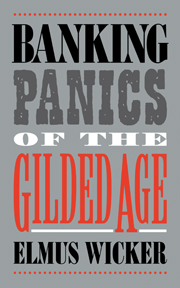Book contents
- Frontmatter
- Contents
- Preface
- 1 The Bank Panic Experience: An Overview
- 2 The Banking Panic of 1873
- 3 Two Incipient Banking Panics of 1884 and 1890: An Unheralded Success Story
- 4 The Banking Panic of 1893
- 5 The Trust Company Panic of 1907
- 6 Were Panics of the National Banking Era Preventable?
- 7 Epilogue
- Appendix
- References
- Index
2 - The Banking Panic of 1873
Published online by Cambridge University Press: 21 October 2009
- Frontmatter
- Contents
- Preface
- 1 The Bank Panic Experience: An Overview
- 2 The Banking Panic of 1873
- 3 Two Incipient Banking Panics of 1884 and 1890: An Unheralded Success Story
- 4 The Banking Panic of 1893
- 5 The Trust Company Panic of 1907
- 6 Were Panics of the National Banking Era Preventable?
- 7 Epilogue
- Appendix
- References
- Index
Summary
The 1873 panic was the first of the banking panics of the national banking era. The fact that it occurred after the passage of the National Banking Act in 1863 is not of as much significance as the response of the New York Clearing House. For a brief interval between 1860 and 1873 the NYCH possessed vigorous leadership. George S. Coe, President of the American Exchange Bank, understood the broader responsibilities of the NYCH as holder of the country's ultimate banking reserve and designer of the two powerful instruments for forestalling banking panics: loan certificates and the pooling of reserves of the associated banks; the loan certificate enabled the member banks to expand loans during the panic episode without the loss of reserves to local banks, and reserve pooling allowed the banks to continue to pay out cash freely to the interior banks. The significance of reserve pooling was recognized by Sprague (1910), who argued correctly that it effectively converted the NYCH into a central bank with reserve power greater than that of any European central bank. Although the NYCH suspended cash payment, it continued to pay out cash freely to interior banks, thereby moderating the effects of the panic. As we see below the suspension of cash payment was probably unnecessary, but, given the knowledge available, understandable. For reasons to be spelled out later, reserve pooling was not repeated in future panics, and by 1893 and 1907 that knowledge had completely evaporated from the collective memory of the NYCH.
- Type
- Chapter
- Information
- Banking Panics of the Gilded Age , pp. 16 - 33Publisher: Cambridge University PressPrint publication year: 2000
- 1
- Cited by

